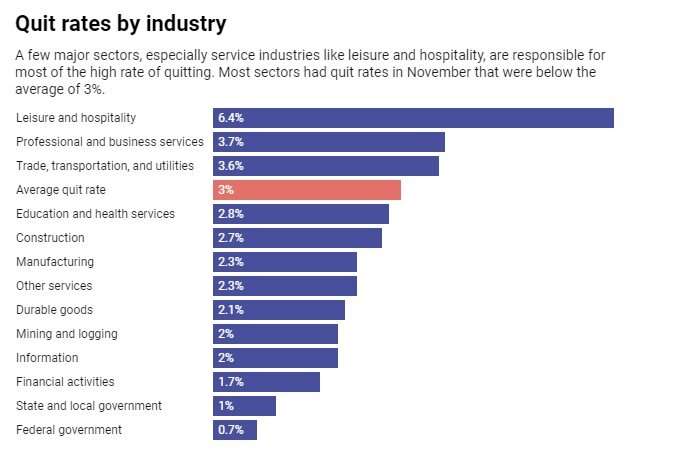The Great Resignation is not as great as headlines suggest, says historical data and a deeper analysis

The so-called Great Resignation as "record" numbers of workers reportedly quit their jobs.
The came out on Jan. 4, 2022, and showed that 4.5 million people voluntarily left their positions in November—an "," according to the agency responsible for collecting the data. That's 3% of the nonfarm workforce, which also level.
But is it?
The "quit rate" because I wrote my economics doctoral thesis . Since then I have been fascinated by how people leave jobs and then find new ones.
Tracking 'quits'
Data on people quitting comes from the .
Each month the bureau runs the . The bureau interviews about 20,000 businesses and government agencies each month, which it uses to estimate several aspects of the workforce, including the number of people who quit, retired, got hired or got fired.
Since April 2021, the share of nonfarm workers who quit their jobs recorded by the bureau. In all, nearly left their positions over this period, or over a fifth of the .
Certainly, that's a lot of people. But a closer look at all the historical data we have can help put this in some perspective.
One issue is calling the current levels a "record." The problem is the data only goes back a little over two decades, which means it's certainly possible that the rate could have been higher at several points in the past. We just don't know.
For example, during the dot-com bubble in the late 1990s and early 2000s, the U.S. economy , which created many new jobs and opportunities for workers. These are to and benefits. Given that the rate was 2.4% in January 2001—a month after the quits data begins—it's not a stretch to imagine it may have been higher than the current level at some point in 2000 or earlier.
Or another time when quits may have been higher was after World War II, when the postwar American economy and the economy was in great flux.
In fact, some data pre-2000 does exist that suggests there are times when the quit rate may have been higher. The Bureau of Labor Statistics tracked the from 1930 to 1979, when it ended the survey because the industry—which at one time —b±ð³¦²¹³¾±ð .
Manufacturing workers, who make things like steel, cars and textiles, were quitting their jobs at a monthly average in 1945, compared with the .
Since about a in the late 1940s, this suggests the overall quit rate was likely higher back then.
Putting quits into perspective
A lot of stories have also focused on the absolute number of workers who quit their jobs, such as 4.5 million who quit in November—on a seasonally adjusted basis.
If quits for December 2021 are similar to November, I expect about 47 million people will have voluntarily left their jobs in all of 2021. That would mean about 33% of the total nonfarm workforce quit jobs last year.
Again, that seems like a lot, but a huge swath of the labor force does this every year. In 2019, for example, quit.
So is quitting higher than normal? For sure. But off the charts enough to earn the moniker of "great"? I don't think so.
Not all sectors are seeing a wave of quitting
Workers also aren't quitting in droves across all sectors of the economy. While quits are higher than usual in most industries, a few sectors are responsible for most of the turnover, with some lower than their recent peaks.
The is in accommodation and food services. About 6.9% of people working in hotels, motels, restaurants and bars gave notice in November. While that's the highest since 2000, voluntary turnover in this sector —given the nature of the work—and has been above 5% many times over the past two decades.
November's second-highest quit rate, at 4.4%, , which includes workers in stores and shops. Combined, these two relatively low-wage industries accounted for one third of all people who quit that month.
On the other hand, the quit rates for , , and are relatively low and have been higher in the past 21 years.
We can also see from the data that young people make up the biggest share of people switching jobs. Data from ADP, one of the largest payroll processors, breaks down turnover by age. But unlike the JOLTS data, ADP doesn't learn why someone is no longer working at a company—whether they quit, got fired or something else—so it can track only total turnover.
high turnover is concentrated among 16-to-24-year-olds, with a turnover rate almost three times the national average.
High turnover for young workers is not surprising, in my view, because COVID-19 restrictions like after-work socializing and company parties. For younger workers new to the labor force, . Without them, there are fewer ties binding these workers to a company.
Reducing the quit rate
Nevertheless, just because the quit rate isn't at a record doesn't mean there isn't a problem of too much turnover in the labor market. But that problem appears to predate the pandemic.
High annual quit rates mean many workers are not satisfied with their job's pay, benefits or working conditions. And that can be a huge waste of time and money for both companies and workers. Hiring and training . And and switching jobs is and for workers.
Research shows employers can minimize turnover by many different methods, such as by , in self-directed teams and .
Individuals thinking about quitting should ideally find another job before quitting. You have a much higher chance of success than trying to .
The next time you hear about the "Great Resignation," understand it isn't quite as great as it seems, since large numbers of U.S. workers have been quitting for years.
Provided by The Conversation
This article is republished from under a Creative Commons license. Read the .![]()



















